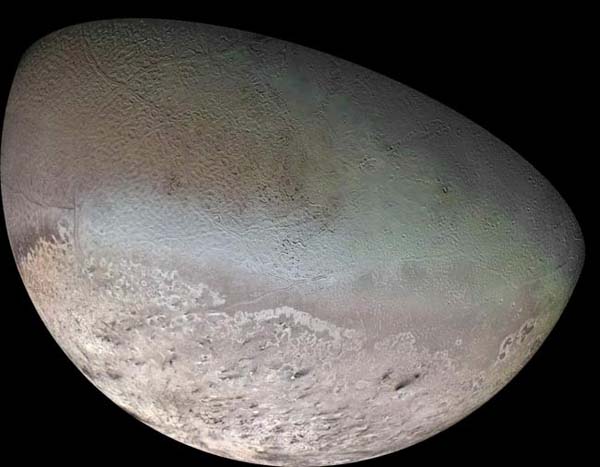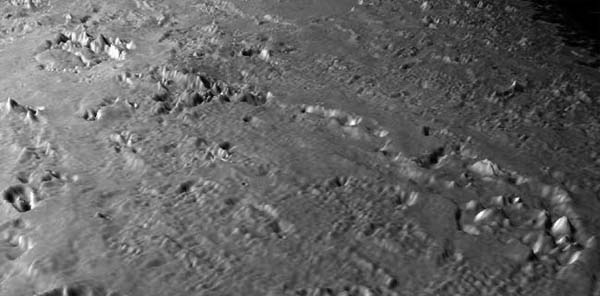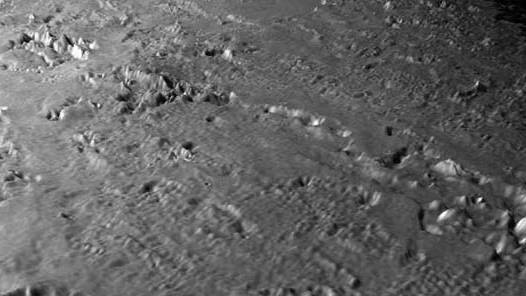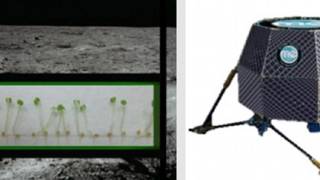Seasons Discovered on Neptune’s Moon Triton
Source: space.com

The thin atmosphere of Neptune’s moon Triton varies in thickness with the seasons and in the throes of summer, despite its relatively large distance from the sun compared to other bodies in the solar system, new observations have found.
The European Southern Observatory’s Very Large Telescope, located in Chile, made infrared observations of Triton which show that summer is in full swing in the moon’s southern hemisphere, and that the warmth of the summer sun causes Triton’s thin atmosphere to thicken.
"We have found real evidence that the sun still makes its presence felt on Triton, even from so far away," said Emmanuel Lellouch of the Observatoire de Paris in France and a member of the team that made the discovery.
The telescope also discovered the presence of carbon monoxide in Triton’s atmosphere and made the first ground-based detection of methane on the Neptunian moon.

Triton, Neptune’s largest natural moon, was the last solid object visited by the Voyager 2 spacecraft on its epic 10-year tour of the outer solar system. This view of Triton was made from topographic mapping of images obtained by Voyager. Credit: NASA/JPL/Universities Space Research Association/Lunar & Planetary Institute.
Of Neptune’s 13 moons, Triton is by far the largest, and, at about 1,700 miles (2,700 km) in diameter (or three quarters of the diameter of the Earth’s moon), is the seventh largest moon in the whole solar system.
Since its discovery in 1846, Triton has fascinated astronomers because of its geologic activity, the many different types of surface ices, such as frozen nitrogen as well as water and dry ice (frozen carbon dioxide), and its unique retrograde motion (which means it rotates around its planet in the opposite direction of its planet’s rotation).
On Triton, where the average surface temperature is about minus 391 degrees Fahrenheit (minus 235 Celsius), it is currently summer in the southern hemisphere and winter in the northern.
As Triton’s southern hemisphere warms up, a thin layer of frozen nitrogen, methane, and carbon monoxide on Triton’s surface sublimates into gas, thickening the icy atmosphere as the season progresses during Neptune’s 165-Earth-year orbit around the sun.
A season on Triton lasts a little over 40 years, and Triton passed the southern summer solstice in 2000.
Based on the amount of gas measured, Lellouch and his colleagues estimate that Triton’s atmospheric pressure may have risen by a factor of four compared to the measurements made by Voyager 2 in 1989, when it was still spring on the giant moon. The atmospheric pressure on Triton is now between 40 and 65 microbars — 20,000 times less than on Earth.
Carbon monoxide was known to be present as ice on the surface, but Lellouch and his team discovered that Triton’s upper surface layer is enriched with carbon monoxide ice by about a factor of ten compared to the deeper layers, and that it is this upper "film" that feeds the atmosphere.
While the majority of Triton’s atmosphere is nitrogen (much like Earth’s, which is 78 percent nitrogen), the methane in the atmosphere, first detected by Voyager 2, and only now confirmed in this study from Earth, plays an important role as well.
"Climate and atmospheric models of Triton have to be revisited now, now that we have found carbon monoxide and re-measured the methane," said team member Catherine de Bergh, also of the Observatoire de Paris.
The new observations of Triton’s atmosphere are detailed in the March 15 issue of the journal Astronomy & Astrophysics.
Pluto, often considered a cousin of Triton and with similar conditions, is receiving renewed interest in the light of the carbon monoxide discovery, and astronomers are racing to find this chemical on the even more distant dwarf planet.
Article from: Space.com
Voyager 2 flyby Animation - Neptune and Triton (1989)
Video from: YouTube.com
Neptune’s moon Triton - Interesting Facts
Video from: YouTube.com






















